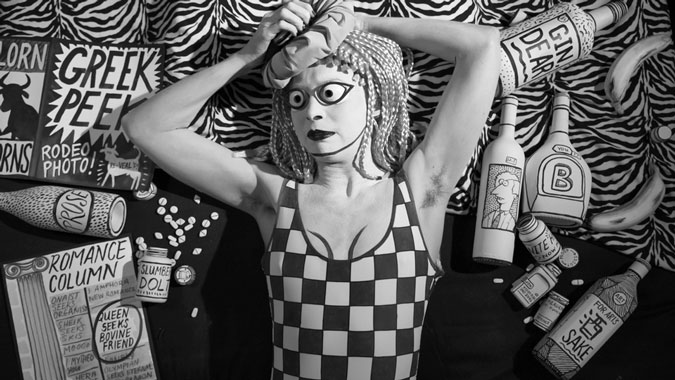
Swinburne’s Pasiphae, 2014 (Video Still)
Mary Reid Kelley with Patrick Kelley
Source: maryreidkelley.com
The explicitness of sexuality in Ancient Greece, the voicelessness of prostitutes during World War I, the spark of revolution in nineteenth century Paris, and the Baudelaire’s ideas about aesthetic beauty and urban landscape: all of these intriguing concepts have served as inspiration for the work of Mary Reid Kelley. Though she originally “started off as a painter,” Kelley has devoted herself to the art of filmmaking. With the help of her husband, artist Patrick Kelley, and some of their family members, Mary Reid Kelley takes on the responsibilities of writing the manuscripts, filming, creating the sets, acting, and finishing all of the post-production work for her films.
In the lecture she delivered on campus November 4, Kelley said,”[I] didn’t start making films until I got so interested in poetry,” particularly that of nineteenth-century French poet, Charles Baudelaire. Baudelaire spent much of his career developing the idea that true artists should “concentrate on making beautiful things for people,” not on “instruct[ing] the public.” Baudelaire’s concept of beauty was much different from the commonly held ideas about beauty at the time, however; for Baudelaire believed that artificial forms of beauty, achieved by items such as corsets and makeup, were truly beautiful, while nature was “amoral.” This concept is central to Kelley’s films, which feature sets entirely built of her own painted designs. All of the costumes in Kelley’s films consist primarily of masks and articles of clothing constructed and painted by Kelley herself. Kelley even paints directly on the skin of her actors and actresses to accentuate certain features and curvatures of the body, as seen above in the still frame from her film Swinburne’s Pasiphae.
Algernon Charles Swinburne is another source of inspiration for Kelley’s work. Swinburne and Baudelaire were not only contemporaries, but good friends, and shared many ideas. Both drew a lot of their work from ancient Greek mythology, and were intrigued by the more explicit sexuality of these stories. For example, Pasiphae’s story centers around her infatuation and mating with a bull, ultimately producing her half-bull offspring, the Minotaur. Kelley is also drawn to the idea that mythological characters such as the Minotaur simply exist in ancient Greek stories due to oral tradition, and are not “authored” by a particular writer. Working on Swinburne’s Pasiphae provided Kelley with a variety of opportunities to explore her artistic passions. Through using Swinburne’s original narrative of the story of Pasiphae for her own film adaptation as well as playing the role of Pasiphae herself, Kelley said she was able to “embody[…] someone that [she] really admire[s],” in this case, Swinburne. Her film certainly explores the “overwhelming desire that you know is bad for you, but you desire it anyway,” an idea that is very present in much of Swinburne’s poetry.
As a final note on poetry, Kelley spoke about the perception of poetry in today’s society as “elitist.” She recounted how her grandfather used to memorize poetry, and how this seems to be a generational pastime. Kelley has a much more personal and artistic connection to poetry, however. She describes “a real poem” as “an impulse on the page,” and claims that she “write[s] things to perform them,” and to help contribute to her artistic expression. Kelley’s point about the shifting perception and practice of poetry is an important one; for poetry is often thought of as being replaced by today’s technology, particularly in television and film. What Kelley’s work suggests, however, is that poetry and film are not mutually exclusive. On the contrary, poetry can be incorporated into film and other forms of media in beautiful and entertaining ways. Perhaps the work of Kelley and other artists will start a revitalization of poetry in mainstream culture and entertainment.
To read more about Mary Reid Kelley and to view some of her films, be sure to visit her website.
